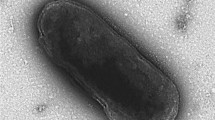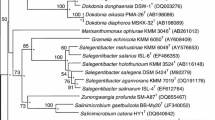Abstract
A Gram-stain negative, strictly aerobic, chemoheterotrophic, tangerine orange pigmented, curved-rod shaped bacterium, designated N5DA8-2CT, was isolated from a sea squirt by use of a bait-streaked agar technique. Phylogenetic analysis based on the 16S rRNA gene sequence indicated that the novel marine strain is affiliated with the family Flavobacteriaceae of the phylum Bacteroidetes and that it shared high (92.6 %) sequence similarity with Frondibacter aureus A5Q-67T. The strain could be differentiated phenotypically from the related members of the family Flavobacteriaceae. The major fatty acids of strain N5DA8-2CT were iso-C15:1 G, iso-C17:0 3-OH, iso-C15:0 and C16:1 ω7c and/or C16:1 ω6c. A polar lipid profile was present consisting of phosphatidylethanolamine and three unidentified amino lipids. The DNA G+C content of the strain was determined to be 41 mol% and the major respiratory quinone was identified as menaquinone 6 (MK-6). From the distinct phylogenetic position and combination of genotypic and phenotypic characteristics, the strain is considered to represent a novel genus in the family Flavobacteriaceae, for which the name Ascidiimonas aurantiaca gen. nov., sp. nov. is proposed. The type strain of A. aurantiaca gen. nov., sp. nov. is N5DA8-2CT (= KCTC 32992T = NBRC 110020T).


Similar content being viewed by others
References
Arun AB, Chen WM, Lai WA, Chou JH, Shen FT, Rekha PD, Young CC (2009) Lutaonella thermophila gen. nov., sp. nov., a moderately thermophilic member of the family Flavobacteriaceae isolated from a coastal hot spring. Int J Syst Evol Microbiol 59:2069–2073
Bernardet JF, Nakagawa Y, Holmes B (2002) Proposed minimal standards for describing new taxa of the family Flavobacteriaceae and emended description of the family. Int J Syst Evol Microbiol 52:1049–1070
Bowman JP, McCammon SA, Brown MV, Nichols DS, McMeekin TA (1997) Diversity and association of psychrophilic bacteria in Antarctic sea ice. Appl Environ Microbiol 63:3068–3078
Collins MD, Jones D (1981) A note on the separation of natural mixtures of bacterial ubiquinones using reverse-phase partition thin-layer chromatography and high performance liquid chromatography. J Appl Bacteriol 51:129–134
Collins CH, Lyne PM (1984) Microbiological methods, 5th edn. Butterworth, London
DeLong EF, Franks DG, Alldredge AL (1993) Phylogenetic diversity of aggregate-attached vs. free-living marine bacterial assemblages. Limnol Oceanogr 38:924–934
Dittmer JC, Lester RL (1964) A simple, specific spray for the detection of phospholipids on thin-layer chromoatograms. J Lipid Res 15:126–127
Felsenstein J (1985) Confidence limits on phylogenies: an approach using the bootstrap. Evolution 39:783–791
Fitch WM (1971) Towards defining the course of evolution: minimum change for a specific tree topology. Syst Zool 20:406–416
Garrity GM, Holt JG (2001) The road map to the Manual. In: Boone DR, Castenholz RW, Garrity GM (eds) Bergey’s manual of systematic bacteriology, 2nd edn, vol 1. Springer, New York, pp 119–166
Glöckner FO, Fuchs BM, Amann R (1999) Bacterioplankton composition of lakes and oceans: a first comparison based on fluorescence in situ hybridization. Appl Environ Microbiol 65:3721–3726
Hameed A, Shahina M, Lin SY, Lai WA, Liu YC, Hsu YH, Cheng IC, Young CC (2014) Robertkochia marina gen. nov., sp. nov., of the family Flavobacteriaceae, isolated from surface seawater, and emended descriptions of the genera Joostella and Galbibacter. Int J Syst Evol Microbiol 64:533–539
Hansen GH, Sørheim R (1991) Improved method for phenotypical characterization of marine bacteria. J Microbiol Methods 13:231–241
Jooste PJ (1985) The taxonomy and significance of Flavobacterium–Cytophaga strains from dairy sources. PhD thesis, University of the Orange Free State
Kim OS, Cho YJ, Lee K, Yoon SH, Kim M, Na H, Park SC, Jeon YS, Lee JH, Yi H, Won S, Chun J (2012) Introducing EzTaxon-e: a prokaryotic 16S rRNA gene sequence database with phylotypes that represent uncultured species. Int J Syst Evol Microbiol 62:716–721
Kimura M (1983) The neutral theory of molecular evolution. Cambridge University Press, Cambridge
Kirchman DL (2002) The ecology of Cytophaga-Flavobacteria in aquatic environments. FEMS Microbiol Ecol 39:91–100
Komagata K, Suzuki K (1987) Lipid and cell-wall analysis in bacterial systematics. Methods Microbiol 19:161–207
Lee DH, Moon SR, Park YH, Lee YS, Jung JS, Kim JH, Kim H, Kahng HY (2011) Gangjinia marincola gen. nov., sp. nov., a marine bacterium of the family Flavobacteriaceae. Int J Syst Evol Microbiol 61:325–329
Ludwig W, Klenk HP (2001) Overview: a phylogenetic backbone and taxonomic framework for procaryotic systematics. In: Boone DR, Castenholz RW, Garrity GM (eds) Bergey’s manual of systematic bacteriology, 2nd edn, vol 1. Springer, New York, pp 49–66
Marmur J (1961) A procedure for the isolation of deoxyribonucleic acid from micro-organisms. J Mol Biol 3:208–218
McCammon SA, Innes BH, Bowman JP, Franzmann PD, Dobson SJ, Holloway PE, Skerratt JH, Nichols PD, Rankin LM (1998) Flavobacterium hibernum sp. nov., a lactose utilizing bacterium from a freshwater Antarctic lake. Int J Syst Bacteriol 48:1405–1412
Mesbah M, Premachandran U, Whitman WB (1989) Precise measurement of the G + C content of deoxyribonucleic acid by high-performance liquid chromatography. Int J Syst Bacteriol 39:159–167
Minnikin DE, O’Donnell AG, Goodfellow M, Alderson G, Athalye M, Schaal A, Parlett JH (1984) An integrated procedure for the extraction of bacterial isoprenoid quinines and polar lipids. J Microbiol Meth 2:233–241
Mitra S, Matsuo Y, Haga T, Yasumoto-Hirose M, Yoon J, Kasai H, Yokota A (2009) Leptobacterium flavescens gen. nov., sp. nov., a marine member of the family Flavobacteriaceae, isolated from marine sponge and seawater. Int J Syst Evol Microbiol 59:207–212
O’Sullivan LA, Weightman AJ, Fry JC (2002) New degenerate Cytophaga-Flexibacter-Bacteroides-specific 16S ribosomal DNA-targeted oligonucleotide probes reveal high bacterial diversity in River Taff epilithon. Appl Environ Microbiol 68:201–210
O’Sullivan LA, Rinna J, Humphreys G, Weightman AJ, Fry JC (2006) Culturable phylogenetic diversity of the phylum ‘Bacteroidetes’ from river epilithon and coastal water and description of novel members of the family Flavobacteriaceae: Epilithonimonas tenax gen. nov., sp. nov. and Persicivirga xylanidelens gen. nov., sp. nov. Int J Syst Evol Microbiol 56:169–180
Perry LB (1973) Gliding motility in some non-spreading flexibacteria. J Appl Microbiol 36:227–232
Quan ZX, Xiao YP, Roh SW, Nam YD, Chang HW, Shin KS, Rhee SK, Park YH, Bae JW (2008) Joostella marina gen. nov., sp. nov., a novel member of the family Flavobacteriaceae isolated from the East Sea. Int J Syst Evol Microbiol 58:1388–1392
Saitou N, Nei M (1987) The neighbor-joining method: a new method for reconstructing phylogenetic trees. Mol Biol Evol 4:406–425
Sasser M (1990) Identification of bacteria by gas chromatography of cellular fatty acids, MIDI Technical Note 101. MIDI Inc, Newark
Tamura K, Peterson D, Petersen N, Stecher G, Nei M, Kumar S (2011) MEGA5: molecular evolutionary genetics analysis using Maximum Likelihood, evolutionary distance, and Maximum Parsimony methods. Mol Biol Evol 28:2731–2739
Thompson JD, Gibson TJ, Plewniak F, Jeanmougin F, Higgins DG (1997) The CLUSTAL_X windows interface: flexible strategies for multiple sequence alignment aided by quality analysis tools. Nucleic Acids Res 25:4876–4882
Weisburg WG, Barns SM, Pelletier DA, Lane DJ (1991) 16S ribosomal DNA amplification for phylogenetic study. J Bacteriol 173:697–703
Worliczek HL, Kampfer P, Rosengarten R, Tindall RBJ, Busse HJ (2007) Polar lipid and fatty acid profiles-re-vitalizing old approaches as a modern tool for the classification of mycoplasmas? Syst Appl Microbiol 30:355–370
Yoon J, Oku N, Park S, Kasai H, Yokota A (2011) Porifericola rhodea gen. nov., sp. nov., a new member of the phylum Bacteroidetes isolated by the bait-streaked agar technique. Antonie Van Leeuwenhoek 100:145–153
Yoon J, Oku N, Park S, Katsuta A, Kasai H (2012) Tunicatimonas pelagia gen. nov., sp. nov., a novel representative of the family Flammeovirgaceeae isolated from a sea anemone by the differential growth screening method. Antonie Van Leeuwenhoek 101:133–140
Yoon J, Adachi K, Kasai H (2014) Citreitalea marina gen. nov., sp. nov., a novel member of the family Flavobacteriaceae isolated from a marine red alga and emended description of the genus Gangjinia. Antonie Van Leeuwenhoek 106:261–269
Yoon J, Adachi K, Kasai H (2015) Isolation and classification of a novel marine Bacteroidetes as Frondibacter aureus gen. nov., sp. nov. Antonie Van Leeuwenhoek 107:321–328
Author information
Authors and Affiliations
Corresponding author
Ethics declarations
Conflict of interest
The authors declare that they have no conflict of interest.
Research involving human participants and/or animals
This article does not contain any studies with human participants or animals performed by any of the authors.
Electronic supplementary material
Below is the link to the electronic supplementary material.
10482_2016_655_MOESM1_ESM.ppt
Supplementary Fig. 1. Thin-layer chromatograms showing the total polar lipid compositions of N5DA8-2CT. Total polar lipids were detected by spraying the plate with molybdophosphoric acid, molybdenun blue, α-naphthol and ninhydrin. PE: phosphatidylenthanolamine, UAL: unidentified aminolipid
Rights and permissions
About this article
Cite this article
Yoon, J., Oku, N. & Kasai, H. Ascidiimonas aurantiaca gen. nov., sp. nov., a member of Flavobacteriaceae isolated from a sea squirt. Antonie van Leeuwenhoek 109, 501–508 (2016). https://doi.org/10.1007/s10482-016-0655-z
Received:
Accepted:
Published:
Issue Date:
DOI: https://doi.org/10.1007/s10482-016-0655-z




